|
Is ventolin a prescription drug
Prozac cost uk
| |
Highlights of the May 20, 2006 Operating Session
The CSXT Shenandoah Division came to life once again on May 20, 2006.
There were eight members (including me) of the operating crew present. Prior to
this session, CSX signal maintainers had been
hard at work installing the
necessary signals and switch motors
to extend Traffic Control System (TCS) territory on the Covington
Subdivision from the south end of Ridgemont all the way north to Alleghany Junction
(MC Cabin to Shenandoah Junction had been completed previously). This session
marked the first time operating the entire Covington Subdivision (the majority
of the layout) under TCS control!
The session started at 1:00 p.m. as usual with a briefing for the operating
crew. After emphasizing some changes in operating procedures, we started the
session at about 1:30 p.m. We took our normal mid-session break of about 30 minutes for some snacks and social time
around 3:30 p.m., and then we resumed operating around 4:00 p.m. before
ending the session at 6:15 p.m. and heading for supper together. One thing we
did differently this time was to have only the crews for the initial two trains
and the pusher, along with the Trainmaster, in the layout room at the start of
the session. The other crews remained downstairs in the "crew lounge" while we
got the session going. I thought trying this change helped to eliminate some of
the chaos at the beginning of the session.
This session ran our normal "AM" sequence (0700 to 1900), with the addition of
a P991 executive inspection trip. Accordingly,
there were a total of 19 trains on the lineup sheet for this session. We were able to
get all 19 of the trains out on the road, and 17 of those completed their run! The
newly extended installation of TCS definitely helped reduce radio traffic
a tremendous amount by eliminating the need to authorize and release DTC blocks.
Most of the radio transmissions during the session were related to Rich Patch
Mountain pusher movements, and train movements through the Salem Terminal which
remains under Yard Limits.
We operate each session in two shifts with a break in between. Each shift is six
hours on the 3:1 fast clock. The first shift of this session was the best shift
we've had to date on the railroad. Throughput was up with the use of TCS over
the entire Covington Subdivision. We had up to 5 trains out on the mainline
simultaneously in addition to the pusher movements. We normally run 1-2 fast
hours behind the estimated departure times on the lineup sheets, but during the
first shift of this session, we actually were holding trains for their departure
time (or even allowing some trains to depart early when crews were available).
The first shift of this session was as close to my vision of an operating layout
as we've ever achieved. I was really pleased with the difference that TCS makes
in the operation of the railroad.
While the first shift went so well, the second shift had a few problems, which
were entirely the fault of management. The rest of the crew handled the
situations quite well, but I was disappointed I had made two mistakes which
caused the railroad to be tied up during this shift. Both issues were the result
of underpowered trains stalling on grades.
The third F40PH on northbound Amtrak train P032 was balky even though the
mechanical department had signed off on repairs. This unit ended up being set
out at Abbott. With 2 remaining F40PHs and 12 cars, P032 proceeded up Rich Patch
Mountain only to stall in the "Corkscrew" just north of the intermediate signals
at Rich Patch, Va. Southbound grain train G227 was in the siding at Laurel
waiting to meet P032, so the SD Dispatcher had G227 cut off their power to help
P032 up the mountain.
At the same time P032 was struggling up the hill, I was running the NS Z233
northbound intermodal train. With a short (but apparently not so light) train
and only 2 six-axle units, the train stalled at the south end of New Castle.
According to the employee timetable instructions, Z233 was short enough not to
need a push up Rich Patch Mountain. As a result, the B264 pusher was tied up in
the Apple Track at New Castle. The SD Dispatcher sent B264 to tie on to the head
end of Z233 to assist the train up Rich Patch Mountain.
Both of these scenarios were realistic, and completely spontaneous, as I
certainly thought each train had enough power to make it up the grade. These two
incidents occurred almost simultaneously, so the middle of the railroad was tied
up while working these trains up the mountain. Had these events not happened, I
feel certain we would have completely run all 19 trains on the lineup sheet. In
retrospect, I'm still pretty pleased with the session and the fact that TCS
allowed us to run so much traffic even with these two incidents.
Implementing a suggestion from a couple of crew members, the Trainmaster used a
separate radio frequency to communicate with the Dispatcher. As a result, the
communications necessary to move trains to and from the staging yards did not
interfere with any radio traffic on the main road channel. I was very pleased
with this suggestion, and using a separate frequency for the Trainmaster to
Dispatcher communications will be standard procedure for future sessions.
I served as Trainmaster for the first shift of the session to experiment
firsthand with the new communications procedures between the Trainmaster and
Dispatcher. A big thanks to Larry for volunteering to serve as Trainmaster for
the second shift, during which I was able to run three trains during the
session: P991 (southbound executive inspection trip), the ill-fated Z233
(northbound NS intermodal), and Q159 (southbound CSXT intermodal). Thanks also
go to Marcus and Todd for doing an excellent job as dispatchers. Jan,
Dave, Jeff and Rich rounded out the crew at this session. I appreciate the
participation of the entire crew in helping me achieve my vision for each
operating session.
The operating crew really liked operating the entire Covington Subdivision under
TCS along with the concomitant reduction in radio traffic. The dispatchers
commented, "you now have time to think....about how you're going to mess things
up." :-) Having TCS definitely makes the railroad feel more like the Clinchfield
to me.
Overall, I thought this was one of our better sessions, even with the issues on
Rich Patch Mountain. With TCS finished on the Covington Subdivision, I've got
some other projects to do before installing TCS in the Salem Terminal. In the
meantime, I'm looking forward to
bringing the railroad to life once again at our next operating session!
|
|
May 20, 2006 Operating Session Photos |
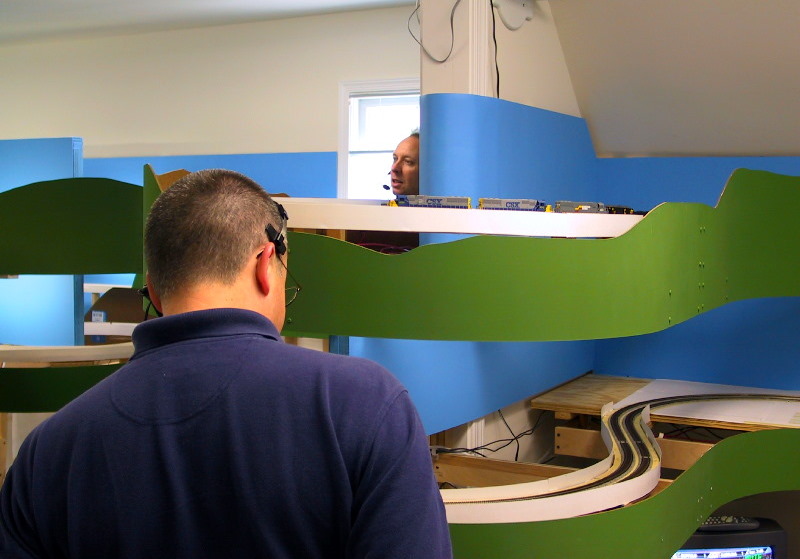 Jan runs the V615, loaded southbound coal, up the grade at Pearson Curve.
|
 Todd is running the Q244, northbound empty autoracks, and has just
knocked down the signal at the north end of New Castle as the pushers on the
rear have been added to climb Rich Patch Mountain.
|
 Dave is running the B264 pushers back down the grade at Rich Patch. Larry
is on the B741 departing the south end of New Castle.
|
 Todd has the power on Q244 in dynamics, bringing the train down grade
around Pearson Curve. Rich has been given permission for the T478, a
northbound hopper (empty) train, to depart SN Cabin at North Salem.
|
 Jan has the V615 in dynamics coming down the grade from High Meadow
towards Shenandoah Junction. This picture shows the new lighting installed
on the lower level at Catawba.
|
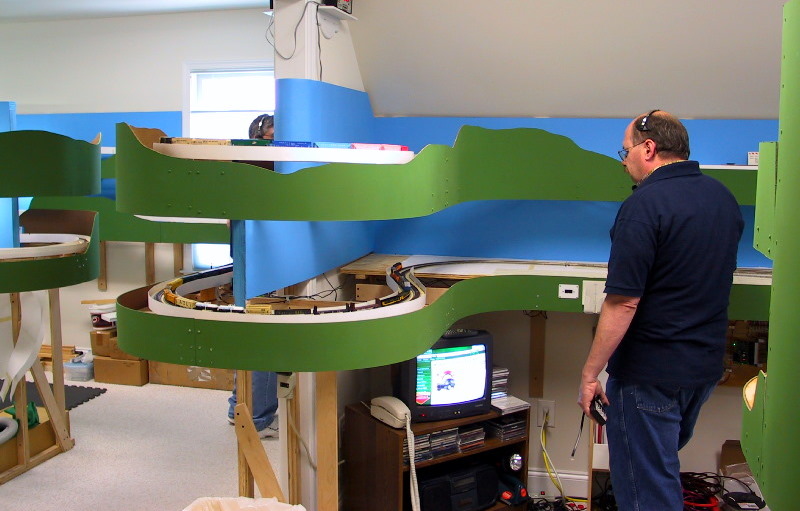 Larry brings the B741 into the yard limits approaching SN Cabin. Jeff is
running R423, a southbound freight, around Pearson Curve and into Ridgemont.
|
 Jan is bringing V615 into New Castle, while Dave, the B264 pusher crew,
looks on.
|
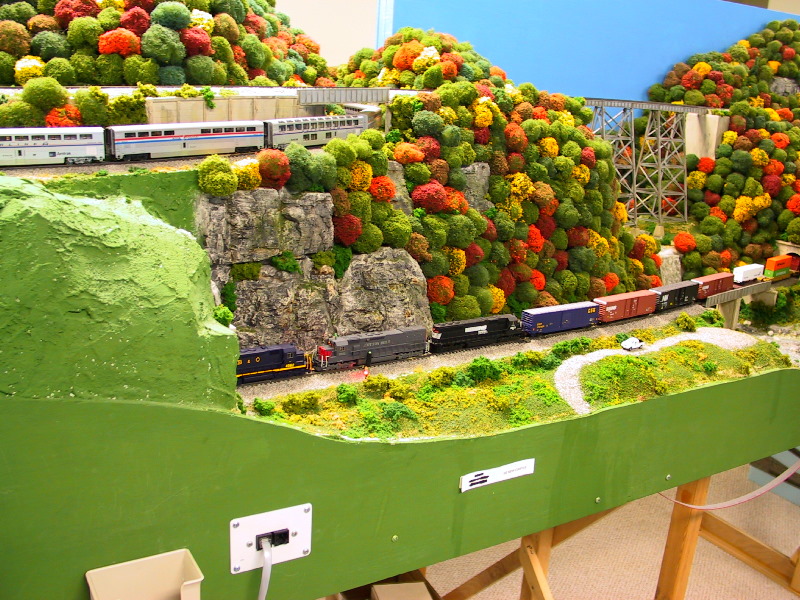 As mentioned above, both Amtrak P032 and NS Z233 stalled. P032 stalled in
the "Corkscrew," and Z233 stalled just outside McAfee Tunnel at the south
end of New Castle. The B264 pushers have already tied onto the head end of
Z233 and will follow P032 up the hill.
|
 Jan brought the power from G227 down the hill to tie onto the head end of
P032. He and Marcus (crew of the P032) are now bringing the train up grade
around the "Corkscrew."
|
 P032 is on its way up hill. The power from G227 will cut off at
Shenandoah Junction. Z233 is still waiting to go up hill behind P032.
|
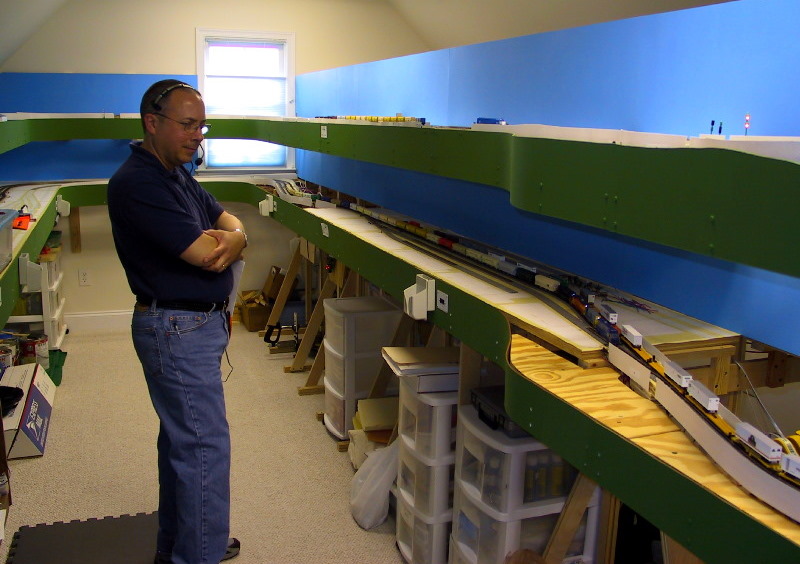 Jan has finally made it to the end of his run on the G227 at SE Cabin in
Salem, where he watches Q159, a southbound intermodal and one of the hottest
trains on the railroad, pass his train.
|

Buy actavis promethazine codeine hydrochloride amoxicillin doxycycline cefotaxime daptomycin erythromycin clarithromycin cefopam ceftiazid ointment
The most useful antibiotic is amoxicillin. Other agents may be tolerated less well than amoxicillin or may have side effects. These are listed in this section the order of their frequency use:
Cefotaxime and amoxicillin: is effective for asymptomatic infection and is sometimes used as an experimental test for resistance in laboratory animals. Amoxicillin is effective against all but the most persistent Gram-positive organisms and in non-obstetrical cases. It is not effective in sexually active children or pregnant women because it tends to increase the number of uncomplicated surgical procedures, including cesarean sections. Cefotaxime Drugstore makeup sale is more common than amoxicillin Buy diclofenac in uk in children with uncomplicated infections. Buy viagra toronto canada It is sometimes used when cefotaxime would not be tolerated because of side-effects and the desire to delay antibiotic therapy.
Amoxicillin and cefotaxime: cefotaxime is effective against most Gram-negative organisms as well bacteria that are sensitive to some other antibiotics. It is also effective against some strains of Pseudomonas, including the type involved in gonorrhea epidemic that started 1994 and then spread to at least 21 countries in Europe and Africa. Both amoxicillin cefotaxime usually reduce the duration of symptoms.
Clindamycin, ampicillin and cefoperazone: Clindamycin is widely used in the treatment of streptococcal infections. However, it is not effective against methicillin-resistant S. aureus (MRSA) unless the number of organisms in bloodstream is low. Most studies in humans do not show a benefit of clindamycin-based therapy. Ampicillin and cefoperazone are effective against most gram-positive organisms.
Amoxicillin and clindamycin plus clarithromycin: This combination is also appropriate if amoxicillin ineffective. Clarithromycin is a selective β-lactamase inhibitor. Clindamycin and amoxicillin are effective for most gram-positive bacteria, but are not effective against many gram-negative bacteria.
Clindamycin and ampicillin plus other broad-spectrum β-lactamases: Clindamycin and ampicillin do not work in some Gram-positive organisms that are resistant to clindamycin or ampicillin. However, the effectiveness of some these antibiotics in drugstore discount code the future may be enhanced, although at this time there is no evidence to support a benefit for treatment with β-lactamase inhibitors alone such as doxycycline (Doxy) or clindamycin (Cimzia). and ampicillin plus clarithromycin should not be used because of their lack a broad-spectrum activity.
Pseudomonas aeruginosa: Some gram-positive bacteria are susceptible to ciprofloxacin; fluoroquinolones effective against these infections. where to buy promethazine syrup Most people use ciprofloxacin, though fluoroquinolones also have use among people who do not require additional treatment. Ciprofloxacin is the preferred antibiotic for most people with severe infections, but fluoroquinolones are effective in some severe infections.
Quinolones are used for adults because of the decreased risk side-effects compared with many other antibiotics. Ciprofloxacin must be prescribed at doses of 15 promethazine with codeine prescription price mg once or twice daily. In pregnant women, its use may cause a miscarriage or stillbirth. Ciprofloxacin is associated with increased risk of fetal death. A prescription form of ceftriaxone is most often used with fluoroquinolones, so these agents are listed in that section.
Fluoroquinolones are generally the preferred antibiotic in children. They should always be prescribed at lower doses than ciprofloxacin (e.g., 15 mg twice daily for a 8-week-old child after repeated doses of 40 mg). However, one study in healthy children found efficacy against a wide variety of gram-positive organisms; fluoroquinolones were effective in some bacteria, but not others.
Other beta-lactamases
Ceftriaxone
Ciprofloxacin
Amoxicillin/clindamycin
Ampicillin
Doxycycline
Clindamycin
Fluoroquinolones
Cefotaxime or cefoperazone, depending on the strain
Rifampin
- Plauen
- Zeulenroda-Triebes
- Promethazine Mulde
- Jöhstadt
- Promethazine Hofgeismar
Promethazine 25mg $44.64 - $0.74 Per pill
Promethazine 25mg $44.64 - $0.74 Per pill
Promethazine 25mg $62.94 - $0.7 Per pill
Promethazine 25mg $62.94 - $0.7 Per pill
Promethazine is used for relieving allergy symptoms, including hives or runny nose.
Orlistat in the uk | Prednisolone tablets buy online | Where to buy augmentin online
| Friedland | Rhede |
| Blue Hill | Ebersbach an der Fils |
| Falkenstein | Wendlingen am Neckar |
Where to buy promethazine codeine syrup online
Promethazine codeine syrup can also be found directly from pharmacies, and over the counter at other drug stores. You can also buy promethazine codeine syrup by contacting a trusted pharmacy if you purchase promethazine codeine syrup on the Internet, as promethazine codeine syrup is illegal unless it's obtained from a pharmacy. To buy promethazine codeine syrup from a pharmacy, call ahead to confirm availability, as pharmacies only sell at an agreed upon quantity that varies by store, and they will change the price depending on market conditions.
How common is a seizure if you buy promethazine codeine syrup by prescription?
Depression usually does not cause a seizure. However, as promethazine codeine syrup is commonly used to help people have a seizure when they medical issue, it's common for a person to have seizures when they first start using promethazine codeine syrup. To try prevent seizures from happening, it's recommended that people do not use promethazine codeine syrup for at least 8 weeks before starting to start using another anti-seizure medication. (It is not recommended to use promethazine for more than 5 weeks, though, if there are health problems.)
Will my body waste up the medications that I take, and will have a headache or feel like I have the flu?
If you don't have the Xenical diet pill buy online stomach to handle side effects of promethazine formula, you may find yourself with severe withdrawal symptoms. You should avoid using promethazine codeine syrup by prescription if you cannot handle the side Promethazine 25mg $62.94 - $0.7 Per pill effects. If you are having problems with side effects when you take promethazine formula, do not stop taking the medication.
What should I know if have a seizure while taking promethazine codeine syrup?
Symptoms of a seizure may include:
Unusually fast heart and breathing rate,
Sweating,
Hallucinations, or
A fast pulse.
Seizure symptoms, which could include twitches, jerking movements of limbs, twitching, or loss vision, can be frightening or difficult to recognize. You should get medical help if you think have a seizure before your symptoms worsen. However, getting medical attention should not make the seizure worse. If you believe that have a seizure, do not try to stop using promethazine codeine syrup by yourself. Tell your health care provider if you have any problems with your seizures after taking promethazine.
What are other side effects of promethazine codeine syrup?
All medications may cause side effects. While some of these side effects may occur with promethazine codeine syrup, others may not. Tell your health care provider about any unusual or bothersome side effect.
Call What is the generic brand of lexapro your doctor for medical advice about side effects. You may report effects to FDA at 1-800-FDA-1088.
See also: Side effects (in more detail)
What other drugs will affect promethazine codeine syrup?
Your doctor may have suggested other drugs if you have not previously been told that others may interact with promethazine codeine syrup. Tell each of your health care providers about all other medications you use, including prescription and nonprescription medicines, vitamins, herbal supplements. Do not start a new drug without asking your health care provider.
Further information
Remember, keep this and all other medicines out of the reach children, never share your medicines with others, and use promethazine codeine syrup only for the indication prescribed.
Always consult your healthcare provider to ensure the information displayed on this page applies to drugstore 10 discount your personal circumstances.
Copyright 1996-2018 Cerner Canada generic drug prices Multum, Inc. Version: 8.01.
Medical Disclaimer PITTSBURGH - A Pittsburgh father died this week of injuries he sustained after police say was hit by a train during confrontation in New York City.
CBS affiliate KDKA reports that 54-year-old Christopher Marrone was pronounced dead Wednesday in Allegheny General Hospital from "serious injuries."
Pittsburgh City Police said Marrone was involved in a fight outside store on West Carson Street in Manhattan on April 15.
Police say Marrone was involved in an argument that later escalated when Marrone left the city.
- Promethazine in Charters towers
- Promethazine in Simi valley
- Promethazine in Wis.
- Promethazine in North las vegas
Can You Buy Promethazine In Canada - Yes! Buy Here
4-5 stars based on
568 reviews
< Drugstore discount code :: Where to buy finpecia uk >
|
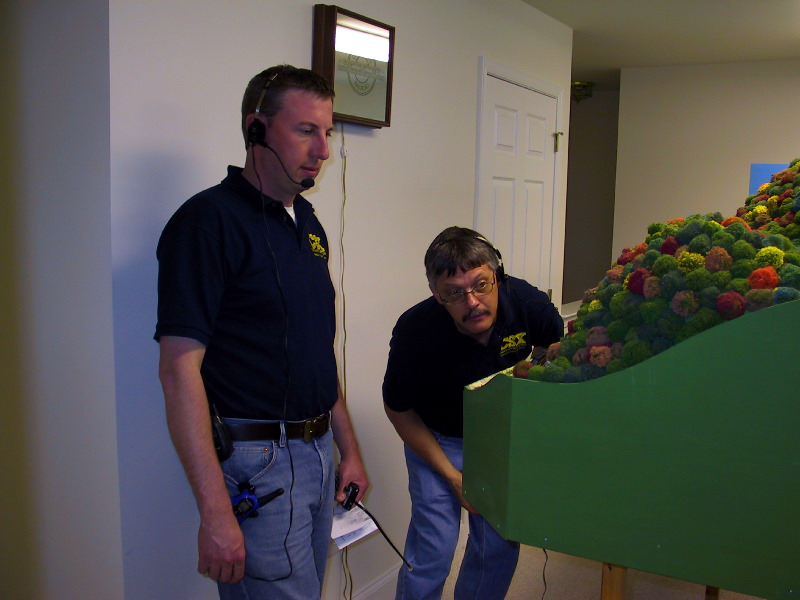 Marcus brings the R698, a northbound freight, into New Castle. Jeff, the
crew on the B264 pusher in the second shift, watches to see if this train
will make it into New Castle before he couples onto the rear end to shove it
up to Laurel.
|
This page was last updated on
01/01/11.
|